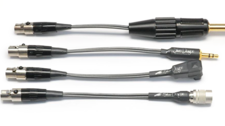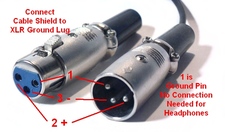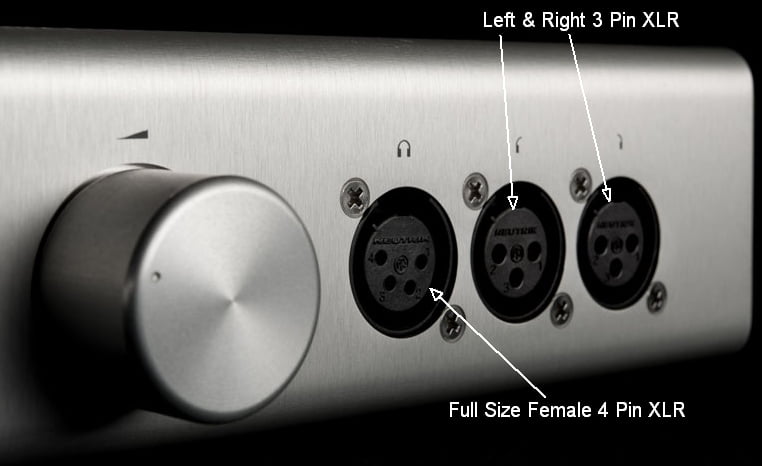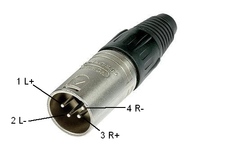It’s the time of year for saving money!
Last week I worked on a review of the new Sony Singature line NW-WM1Z. As I looked down at the Sony NW-WM1Z player’s 4.4mm diameter balanced connection I wondered, how many balanced headphone connection “standards” are there?
And, after a few moments thought, I wondered how many do we really need?
 Before we can answer the second question we must answer the first. So, here goes…currently, there are seven balanced headphone connection schemes for passive headphones and one additional connection for balanced, active, electrostatic headphones. And they are in no particular order:
Before we can answer the second question we must answer the first. So, here goes…currently, there are seven balanced headphone connection schemes for passive headphones and one additional connection for balanced, active, electrostatic headphones. And they are in no particular order:
Dual 3 pin XLR
Single 4 pin XLR
Kobicon miniature 4 pin plug
4 pole 3.5mm plug
4 pole 2.5mm plug
Mini 4 pin XLR
5 pole 4.4mm plug
5-pole connector for electrostatic headphones
The next question is who uses these various connections?
A single 4 pin XLR is the oldest, most ubiquitous, and closest to a universal standard balanced connection. I have reviewed dozens of preamplifiers, integrated amps, and dedicated headphone amplifiers that used this connection. The disadvantage of a single 4 pin XLR is its size, weight, and overall shape make it less than ideal for small and portable components.
Another balanced connection methodology is the dual 3 pin XLR. This has three connections in each XLR housing +, -, and the ground. Again, the primary disadvantage of this system is even more bulk than a single XLR.
One of the first balanced connections developed for portable devices was the Kobicon miniature 4 pin plug. It is used by Ray Samuels, ALO Audio, Cypher Labs and Centrance for their portable headphone amplifiers.
There are two other variations on the 4-pole configuration. HiFiMan uses a 4 pole plug with a 3.5mm diameter. The 4 pole 2.5mm version of this plug is used on Astell & Kern, Onkyo, ALO, and Pioneer players as well as some portable headphone amps.
The last couple of balanced connection methodologies are even less universally accepted. RHA Dacamp L-1 uses a mini 4 pin XLR, which gives them an exclusive on this connection (which may not be a good thing.)
The last connection for passive headphones is the 5 pole 4.4mm plug. This is the connection I found on the new Sony NW-WM1Z. Sony is trying to push this as standard balanced connector for the Industry. I wish them good luck.
For Electrostatic Headphones there is a “universal” 5-pole connector. It is a balanced connection with a + and – R and L as well as a 5th leg for headphone’s bias voltage.
 Perhaps, this is a good time to backtrack a bit – what exactly IS a balanced headphone connection? A balanced headphone cable needs a headphone jack with 4 connections. A balanced headphone cable has 4 wires of equal impedance to carry the stereo signal. The 4 wires are for: Left +, Left -, Right + and Right -. This 4 wire balanced line cancels RFI and radio magnetic interference (RMI) naturally due to each stereo channel’s two equal length and gauge wires both picking up the same electrical noise. One wire is positive and the other is negative so when the signal from the two wires is combined at the speaker the added noise cancels itself out. Adding a grounded shield to a balanced line offers even more electronic noise protection. Balanced connections also offer the potential for increased power output from a headphone amplifier since it can use two amplifiers, one for each channel.
Perhaps, this is a good time to backtrack a bit – what exactly IS a balanced headphone connection? A balanced headphone cable needs a headphone jack with 4 connections. A balanced headphone cable has 4 wires of equal impedance to carry the stereo signal. The 4 wires are for: Left +, Left -, Right + and Right -. This 4 wire balanced line cancels RFI and radio magnetic interference (RMI) naturally due to each stereo channel’s two equal length and gauge wires both picking up the same electrical noise. One wire is positive and the other is negative so when the signal from the two wires is combined at the speaker the added noise cancels itself out. Adding a grounded shield to a balanced line offers even more electronic noise protection. Balanced connections also offer the potential for increased power output from a headphone amplifier since it can use two amplifiers, one for each channel.
Now, back to the multiple connection dilemma. If you own a pair of headphones with a permanently attached cable you must, at the time of purchase, decide how it will be terminated. Most headphones priced under $300 with a permanently attached cable come standard with a single-ended unbalanced ¼” stereo barrel connection. If you want to run them from a balanced connection you must either change the cable to a balanced connection or use an adapter. Using an adapter will not preserve a true balanced signal because the headphones are not wired for stereo at the other end where the cable connects to the transducers – for that you will need to rewire the headphones.
If your headphones have a removable, replaceable cable going to a balanced connection is much easier, right? All you need to do is buy the right cable. This can be harder than it sounds. Moon Audio, who specialize in portable audio have 21 different terminations for full-sized headphones and 8 for IEMs. If you have two main headphones – one full-size and one in-ear and a home and two portable players you could end up needing six balanced cables. And any time you add another headphone, you will need another set of at least three more cables.
 Since I do this professionally, I have one standard file cabinet dedicated to nothing except headphone cables. And even with this resource I often find I need to get an additional cable (or two) from a manufacturer before I can completely review a pair of new headphones or portable player.
Since I do this professionally, I have one standard file cabinet dedicated to nothing except headphone cables. And even with this resource I often find I need to get an additional cable (or two) from a manufacturer before I can completely review a pair of new headphones or portable player.
The takeaway from all this is that the balanced terminations on your next player or pair of headphones can and often do play a part in the decision-making process of choosing a new toy. If you already have a headphone with balanced 4-pole 2.5mm barrel connectors you will save money and time by getting a new component that also uses those connections.
And while I would not, without a heck of a lot of listening and testing even begin to opine as to which balanced connection methodolgy is “best,” I will venture to say that if you have an amplifier and a pair of headphones with balanced connection capabilities, they will work much better if you have the right terminations on the headphone cable that connects them together.
Large Cover photograph courtesy of Lee Shelly Photography









